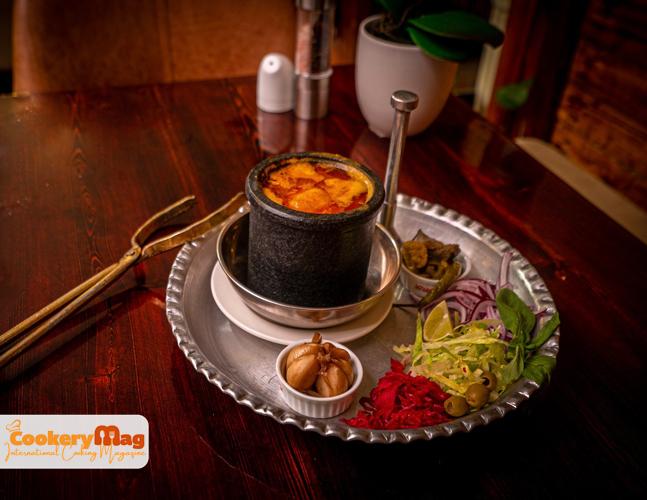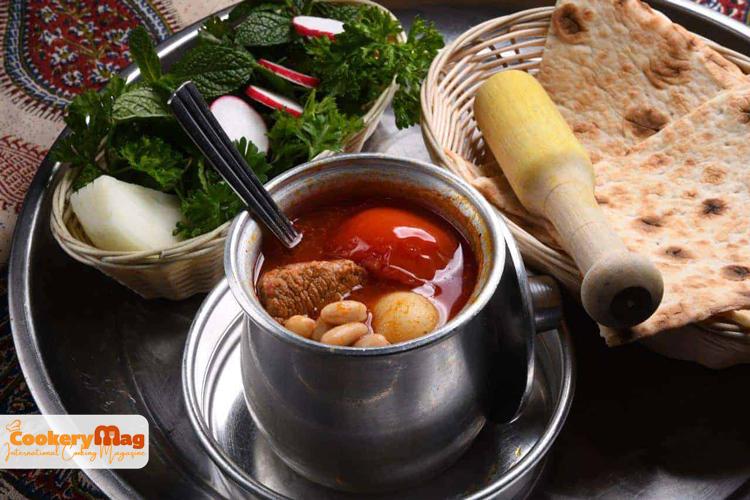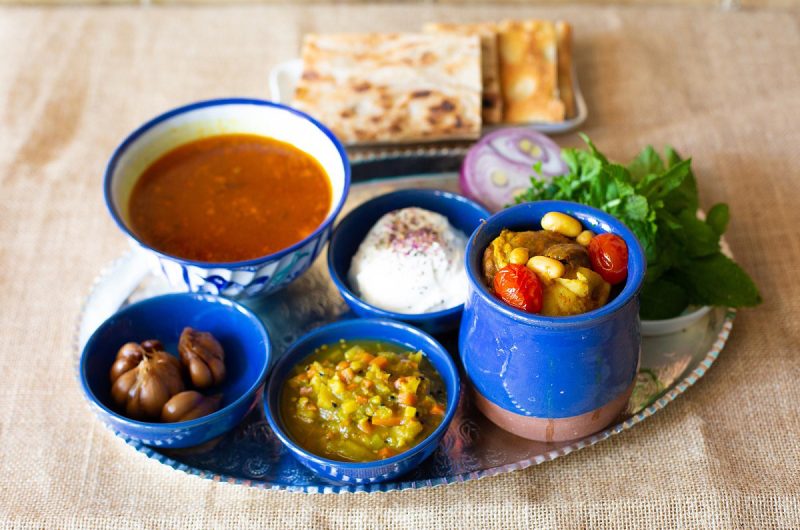© All Rights Reserved.
Dizi Recipe | Persian Lamb Stew in 8 steps
Dizi, shorba, or abgoosht is a delicious and authentic Iranian food; unfortunately, these days, less attention has been paid to this old food.
To have an amazing journey and discovery in the world of Dizi, follow us in Cookery Magazine.
Ingredients for making Dizi
| Lamb shank | 500 grams |
| White beans (Navy bean) | ½ a cup |
| Chickpeas | ½ a cup |
| Tomato | 2 medium sizes |
| potatoes | 2 medium sizes |
| Onions | 2 medium sizes |
| Tomato paste | 2 tablespoons |
| Salt and black pepper | As much as needed |
| Turmeric | As much as needed |
To make the broth (Abgoosht) taste slightly sour, dried lime is added to it in some places.
Of course, you should be careful that the dried lime does not make the Abgoosht taste bitter. We can use two methods to prevent the Abgoosht from becoming bitter.
The first method uses powdered dried lime; the second is to put it in boiling water for a few minutes before adding dried lime to remove its bitterness.
For better broth quality, it is recommended to use homemade dried lime.
Recipe for making Dizi
The first step
To prepare traditional Abgoosht, it is better to soak chickpeas and white beans in two bowls of water separately the night before, and if possible, change the water in the bowls several times so that the swelling of the beans is completely removed and they are easier to cook.
The second step
Pour some oil into a pot and add the meat to start cooking. Fry the meat well until it changes color, then rinse the peas and beans, add them to the pot, and fry them for about a minute.
The third step
At this stage, we add the tomato skin and one of the onions to the pot, then add eight glasses of boiling water. One of the important points about making the abgoosht tastier is to add boiling water.
The fourth step
We reduce the heat under the pot and let the abgoosht cook with a very gentle heat. After you add the boiling water, let your abgoosht ingredients stay on low heat for 2-3/30 hours until the abgoosht thickens.

The fifth step
After 2 hours and 30 minutes, we wash the potatoes and add them to the pot. After adding the potatoes, remove the fat in the pot and beat it well with the remaining onion until they are completely crushed, then add it to the pot again.
The sixth step
After the meat is fully cooked, fry the tomato paste well in a small pan until it is fried, then add it to the pot along with some salt and black pepper. Roasting tomato paste makes our abgoosht more colorful.
The seventh step
After adding the tomato paste, we let the abgoosht stay on low heat for another 30 minutes until it fully settled, then we took it off the heat and set it aside.
The eighth step
You can serve the broth in two ways:
The first and traditional method is to serve the abgoosht separately, beat the rest of the ingredients well with a meat grinder, and serve the pounded meat separately. The second method is adding beans and meat to each person’s bowl.
Having a journey in the history of Dizi (Abgoosht)
Some consider the history of Dizi to be related to Iranians’ old nomadic way of living and animal husbandry.
But many also believe that Persian Lamb Stew became popular after the settlement of humans, the making of clay and stone vessels, and, of course, the construction of old cities; the documents show that this Iranian dish’s age goes back to the 8th century.
As everyone knows, Dizi (Abgoosht) is an authentic, delicious, and, of course, special food, which, unfortunately, these days has a small place not only among our tables but as an authentic Iranian food, which usually most people choose kebab to introduce Iranian dishes.
Also, Sami Zubaida, as an anthropologist who has studied in the category of food and culture, considers Abgoosht to be one of the unique Iranian dishes, which is a unique combination of Meat and beans, lemon, and other seasonings that is eaten by mixing it and the rest of its ingredients are They make a dumpling-like dough.

It is worth mentioning that “Water Chickpea, the great ancestor of Abgoosht (Dizi).”
Jean Chardin is a French tourist who visited Iran at the end of the Safavid period and described a dish similar to today’s Abgoosht as the traditional food of Iranians.
He says, “The common food of Iranians is a dish made of meat, vegetables, and cooked peas, which is brought to the table before rice.”
In addition to Chardin, Jakob Eduard Polak, a physician and traveler who visited Iran during the Qajar period, tasted Iranian Dizi: “Meat is cooked in water, and peas are poured into it; It is called pea broth or Persian Lamb Stew. They bring it to the table with a portion of Meat.
The oldest document in which Abgoosht is mentioned is Divan Atame (دیوان اطعمه), written by Mulana Jamal al-Din Abu Ishaq Hallaj Atema Shirazi, one of the poets and satirical writers of the 9th century.
In his book, he wrote about the description of Iranian food and wrote poems about the broth.
Is Dizi the same as Abgoosht?
Regarding dizi and its difference from Abgoosht, it is necessary to explain that actually, dizi refers to the container in which the abgoosht is cooked.
In the old days, Abgoosht was cooked in special clay, copper, or stone containers, which are now very rare in homes, and only families who are interested in preserving traditions use dizi to cook Abgoosht.
In the Dehkhoda dictionary, the word “dizi” means a small clay cooking dish or a pot made of baked mud. , A kind of clay pot in which they cook mostly meat and sometimes soup.

Dizi is a dish in which the broth is cooked. Although the use of dizi for cooking abgoosht has decreased with the introduction of pots and pans, many people still consider real abgoosh to be cooked in dizi.
It is important to use dizi for cooking abgoosht because using this dish, the ingredients are cooked slowly for a long time; in this way, the food gets a special aroma and taste.
There are 3 types of dizi: stone, clay, and copper dizi, and clay dizi is usually more popular.
According to Jafar Shahri in the book “Tehran in the Thirteenth Century,” Tehran’s dizi cooking had even more distant days.
How did they cook dizi?
Clay dizies were arranged on a stove that burned with wood, broad beans, and bones. dizies were loaded for 16 to 17 hours; That is, if the food were for noon, they would cook from the previous day’s evening, and if it was for dinner, from the beginning of the morning.
The other place where he could find Dizi and abgoosht was public baths!
Dizi was usually placed on the top of the bathtub, and at noon, in the dressing room of the bath, a table was spread, and everyone was busy eating it with their hands.
The grace of dizi in the bath was that those who sat on a dish had clean hands.
In Sangak bakeries, putting dizi loads on the road was the same custom. Some businessperson and tradesperson would give their dizi to the bakers on the way to the shop to put it next to the oven.
Conclusion
Thank you for being with us and providing this delicious and popular food. If you have any questions, it’s my honor to answer. Enjoy your exploration of Persian cuisine!
Please share this article with your friends on Facebook, Twitter, Pinterest, and other social media. 🧡
Dizi Recipe
Course: Persian Food4
servings30
minutes4
minutes300
kcalIngredients
Lamb shank, 500 grams
White beans (Navy bean), ½ a cup
Chickpeas, ½ a cup
Tomato, 2 medium sizes
potatoes, 2 medium sizes
Onions, 2 medium sizes
Tomato paste, 2 tablespoons
Salt and black pepper, As much as needed
Turmeric, As much as needed
Directions
- The first step
To prepare traditional Abgoosht, it is better to soak chickpeas and white beans in two bowls of water separately the night before, and if possible, change the water in the bowls several times so that the swelling of the beans is completely removed and they are easier to cook. - The second step
Pour some oil into a pot and add the meat to start cooking. Fry the meat well until it changes color, then rinse the peas and beans, add them to the pot, and fry them for about a minute. - The third step
At this stage, we add the tomato skin and one of the onions to the pot, then add eight glasses of boiling water. One of the important points about making the abgoosht tastier is to add boiling water. - The fourth step
We reduce the heat under the pot and let the abgoosht cook with a very gentle heat. After you add the boiling water, let your abgoosht ingredients stay on low heat for 2-3/30 hours until the abgoosht thickens. - The fifth step
After 2 hours and 30 minutes, we wash the potatoes and add them to the pot. After adding the potatoes, remove the fat in the pot and beat it well with the remaining onion until they are completely crushed, then add it to the pot again. - The sixth step
After the meat is fully cooked, fry the tomato paste well in a small pan until it is fried, then add it to the pot along with some salt and black pepper. Roasting tomato paste makes our abgoosht more colorful. - The seventh step
After adding the tomato paste, we let the abgoosht stay on low heat for another 30 minutes until it fully settled, then we took it off the heat and set it aside. - The eighth step
You can serve the broth in two ways:
The first and traditional method is to serve the abgoosht separately, beat the rest of the ingredients well with a meat grinder, and serve the pounded meat separately. The second method is adding beans and meat to each person’s bowl.


